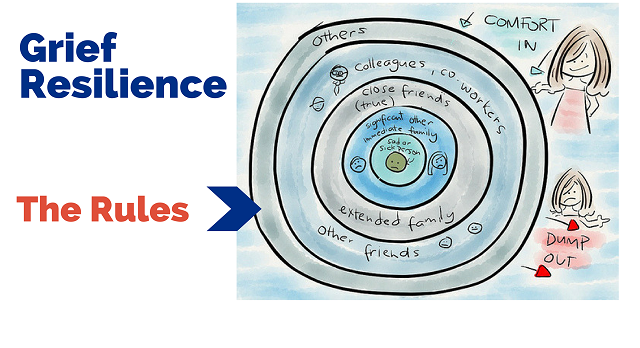How to Build a Compassionate Workplace (Dealing with Grief and Loss)
It’s likely that you, or someone you know, has experienced grief and loss.
Death, illness and challenging times are a part of life, but many of us are not equipped to communicate skillfully with others at these times, particularly in the workplace.
Let’s face it, having conversations about death, tragedy, illness and challenging times are not easy or comfortable, but at some point, we’ll all face a situation when we’re going to need to do so.
Watch the MasterClass extract above on Building a Compassionate Workplace, where Sandra interviews The GroundSwell Project Executive Director, Jessie Williams.
The GroundSwell Project was established 5 years ago to enable social and cultural change when it comes to death and dying in Australia. Their aim is to promote resilience and wellbeing in response to end-of-life issues and to encourage people to build their death literacy. Their goal is to make it easier for people to talk with someone who is experiencing grief and loss and to help kindness to show its face.
They’re wanting to help build more Compassionate Workplaces!
[Don’t like videos? Video Transcription Below!]
How to Build a Compassionate Workplace (Dealing with Grief and Loss)

Sandra: When we were preparing for today, we talked about something called the kvetching circle, which I had never heard of before, which helps people with some of these conversations.
So, can you take us through this kvetching circle and the rules for conversations now to help people understand this?
Jess: Yeah, so we’re talking about individual resilience, and this about how to respond as a group, as a network of people, because we’re so poor at it, really.
This is titled, this is from an article in LA Times and Op Ed in 2013 and it was titled “How Not to Say the Wrong Thing”, it’s a double negative, so it’s a bit confusing, but this woman called Susan came up with the kvetching circle, and I believe kvetch is a Yiddish word for … you know what? I’ve got to google it.
I think kvetch is supposed to be expressing negative emotion.
Sandra: It’s like a complaint.
Jess: Yeah, complaining.
Sandra: Yeah.
Jess: Yeah, yeah. It’s also known as the ring theory.
So, the idea or the general idea here is that in an uncomfortable situation in our context here, death, and dying, and loss, the point is that we’re trying to push comfort towards the centre of the situation, and we’re trying to push stress or negativity outwards. So, the idea being that we’re trying to not make things emotionally worse for those who are at the centre.
So, what do we mean by centre?
Well, if say we actually drew this situation for perhaps an experience that we’ve been in where somebody has died, we start with the person in the centre, so the person who is unwell, or the person who is grieving. The person who is going through the hard time, and then we start to note people who are most closest to them, so their significant other, their immediate family.
We might then go to the next ring which is their close friends and might then be their colleagues.
It might then be their neighbours, and so on and so forth, and so the idea is that if we are mindful of our own role, as it relates to where we’re placed in this ring model, then it will inform what we need to do.
So, if we are at the centre, our job, our role is to receive the comfort.
If we are towards the outer of this model, our job is to help the people in the centre dump out their stress, dump out their negativity. So, I think some examples of where this is not used is when you’ve got a person who’s relatively not close to somebody who’s going through a really hard time, and that person makes it about them.
They might over-identify, “Oh, I’ve been through that, too,” and they make it about them.
So, the idea is that we nurture the people who are closest to that person who’s going through the hardest time.
We need to understand our role and where we are in it in this model, and when I first saw this, I thought, “What if a workplace had this? Wouldn’t that be awesome?”
And my own experience was that my boss recognised that my two closest colleagues needed to be empowered to be close to me while I was going through my hard time. So, she went to Beth and Helen and she said, “Beth and Helen, your job is to be with Jess and to take her out for a coffee at least once a week and have a check in with her,” because she recognised that she was not in the inner circle. She was two rungs out, but she empowered people who were close to me.
Sandra: That’s great.
Jess: Yeah.
Sandra: That’s quite practical, isn’t it?
So, let’s talk a little bit more about some of the things not to say.
You mentioned earlier that there are some examples. Let’s go really into some very practical specific things now around building our skill around death literacy. Let’s start with what not to say to someone.
Dealing With Grief and Loss – What NOT to Say
Jess: No euphemisms.
Sandra: Right.
Jess: No euphemisms.
Sandra: What do you mean by that?
Jess: I would love to ask the group. “What are your examples?”, but look, euphemisms are poor language that we bring in because we have a death-denying society.
So, things like, “Everything has a meaning,” that’s my favourite. It’s not. I’m being facetious.
“God doesn’t give you what you can’t handle”.
“Grief is a journey.”
We made these platitudes that actually what they’re really saying is that we’re rejecting that person’s experience.
It’s too uncomfortable.
It’s too hard.
So, we’re going to slap on a cliché and that’s going to make it all better.
But what happens is the person on the receiving end of that says, “Well, you’ve just rejected my experience because that’s meaningless to me.” So, I think number one, it’s so easy to…

Sandra: It’s part of the discomfort isn’t it?
That uncomfortableness, so it’s like, “I don’t know what to say, so I’ll fumble and say something that maybe someone said to me, or that I think’s the right thing to say,” but it’s that sense of the skill level going to another level can make a huge difference if we know what to say.
Jess: Yeah, but even saying, “I don’t know what to say,” is much better than coming up with a euphemism.
Sandra: Yeah.
Jess: I work in this space, and sometimes I don’t know what to say, and so I say, “I just don’t know what to say,” and the other person is so generous with me. They’ll say, “That’s okay. I don’t know how to feel. We’re even.”
Dealing With Grief and Loss – What to Say
Sandra: Yeah, that’s right. So what can people say?
Jess: Yeah, look, well… empathise with extreme honesty.
So, be extreme with your empathy.
It might sound something like, “I know you are hurting. I am here for you.”
Be direct.
Call out the elephant.
Don’t tippy-toe around it.
You can say, “I am so sorry.”
Now, you might get back, “Well, it’s not your fault,” which is fine, but it’s not a euphemism.
You can use the words dying, died, or dead. You can practise using the D word.
It’s very weird for a lot of people to use those words, which I totally respect.
So, it does take a bit of practice, but it’s good to use those words.
If you know the person that’s died and you’re speaking to the survivor, share the memories of that person as a gift, to share the memories, and lastly this might sound a bit surprising, but it’s not that helpful to say, “What can I do?”
It’s certainly not very helpful to say, “Call me if you need anything.”
The person going through grief doesn’t need to be expected to go into their high functioning brain to work out what to ask you what to do. So, it’s much better to say something like, “I can do this, or I can do that. Which one is more helpful for you?”
Make it easy on that person.
So, the idea here is like you’re being half a step behind that person, but you’re not leading them anywhere.
It’s not your job to have to make sense of their experience or take them anywhere, but be close to them in their experience, and practise empathy with them.
Sandra: So, you’re just letting them know really that you’re thinking about them, and that you’re sharing your empathy. You’re articulating your empathy.
Jess: Yeah. Even when you don’t know what to say.
Subscribe to the PODCAST of the Great Managers® MasterClass











